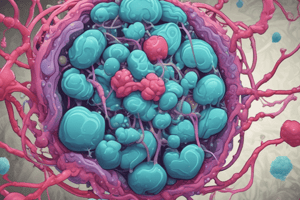Podcast
Questions and Answers
What is a characteristic of Bacillus species?
What is a characteristic of Bacillus species?
- They form spores centrally located (correct)
- They are anaerobic
- They are typically found in aquatic environments
- They are gram-negative
How do humans typically contract anthrax?
How do humans typically contract anthrax?
- Through contact with infected animals
- Through vectors such as ticks and mosquitoes
- Through ingestion of contaminated food
- Through injured skin, mucous membranes, and inhalation of spores (correct)
What is the function of the poly-D-glutamic capsule in Bacillus anthracis?
What is the function of the poly-D-glutamic capsule in Bacillus anthracis?
- It helps the bacterium adhere to host cells
- It stimulates a protective response from the immune system
- It's a polysaccharide capsule
- It doesn't stimulate a protective response from the immune system (correct)
What is the main characteristic of cutaneous anthrax?
What is the main characteristic of cutaneous anthrax?
What is the diagnostic test used to detect the poly-D-glutamic capsule?
What is the diagnostic test used to detect the poly-D-glutamic capsule?
What is the primary cause of Gastrointestinal anthrax?
What is the primary cause of Gastrointestinal anthrax?
What is the characteristic of Bacillus cereus in semisolid culture media?
What is the characteristic of Bacillus cereus in semisolid culture media?
What is the primary treatment for Inhalation anthrax?
What is the primary treatment for Inhalation anthrax?
What is the primary cause of the Emetic type of food poisoning caused by Bacillus cereus?
What is the primary cause of the Emetic type of food poisoning caused by Bacillus cereus?
What is the primary treatment for Bacillus cereus infections?
What is the primary treatment for Bacillus cereus infections?
Flashcards are hidden until you start studying
Study Notes
Gram-Positive Spore-Forming Bacilli
- Bacillus and Clostridium species are ubiquitous and can survive in the environment for many years due to their ability to form spores.
Bacillus
- Large, aerobic, gram-positive rods occurring in chains.
- Spores are centrally located.
- Saprophytic organisms, ubiquitous in soil.
Bacillus anthracis
- Causes fatal sepsis in grazing mammals, such as cattle and sheep.
- Characterized by Medusa-head (curled hair) colonies.
- Poly-D-glutamic capsule, unusual because it's composed of amino acid residues, not polysaccharide.
- Capsule can be detected by the McFadyean reaction.
- Produces protective antigen (PA) that combines with edema factor (EF) and lethal factor (LF) to form toxins.
- Enters humans through injured skin, mucous membranes, and inhalation of spores into the lungs.
Clinical Disease
- Cutaneous anthrax: results from contact with material containing anthrax endospores, over 90% of anthrax cases.
- Characterized by a pruritic papule with a central black eschar.
- Gastrointestinal anthrax: rare form of anthrax, caused by ingestion of undercooked food containing anthrax endospores.
- Symptoms: abdominal pain, vomiting, and bloody diarrhea.
- Inhalation anthrax (Woolsorter’s disease): most dangerous form of anthrax.
- Causes hemorrhagic necrosis, edema of mediastinum, substernal pain, pronounced mediastinal widening, hemorrhagic pleural effusions, and sepsis.
Prevention and Treatment
- AVA BioThrax vaccine: 0.5 mL I.M. at 0 and 4 weeks, then at 6th, 12th, 18th months, then annual booster.
- Treatment: Ciprofloxacin, Pen G with Gentamicin or Streptomycin.
- Prophylaxis: Ciprofloxacin/Doxycycline with vaccine for 4 weeks, without vaccine for 8 weeks.
Bacillus cereus
- Part of the normal flora of the human intestine.
- Usually found in grains like rice.
- Characterized by “swarming movement” in semisolid culture media.
- Produces an enterotoxin that causes food poisoning.
- Heating food does not always kill the spores, which germinate as the food cools.
- Causes:
- Emetic type: nausea, vomiting, abdominal cramps, and diarrhea.
- Diarrheal type: profuse diarrhea with abdominal pain and cramps.
- Eye infections: severe keratitis, endophthalmitis, and panophthalmitis.
- Endocarditis, meningitis, osteomyelitis, and pneumonia.
- Treatment: usually self-limiting, but in severe cases, oral rehydrating salt (ORS) can be used to prevent dehydration.
- For penicillin-resistant strains, use Vancomycin or Clindamycin with or without an aminoglycoside.
Studying That Suits You
Use AI to generate personalized quizzes and flashcards to suit your learning preferences.




